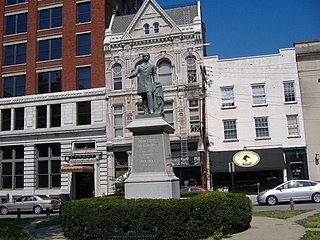
Port Allen is a city in, and the parish seat of, West Baton Rouge Parish, Louisiana, United States. Located on the west bank of the Mississippi River, it is bordered by Interstate 10 and US Highway 190. The population was 4,939 in 2020. It is part of the Baton Rouge metropolitan statistical area.

Allendale Charter Township is a charter township of Ottawa County in the U.S. state of Michigan. At the 2020 Census, the township population was 26,583. Allendale Charter Township is best known as being home to the main campus of Grand Valley State University.

Oxford is a town in Granville County, North Carolina, United States, with a population of 8,628 as of the 2020 census. It is the county seat of Granville County.

Monument Avenue is a tree-lined grassy mall dividing the eastbound and westbound traffic in Richmond, Virginia, originally named for its emblematic complex of structures honoring those who fought for the Confederacy during the American Civil War. Between 1900 and 1925, Monument Avenue greatly expanded with architecturally significant houses, churches, and apartment buildings. Four of the bronze statues representing J. E. B. Stuart, Stonewall Jackson, Jefferson Davis and Matthew Fontaine Maury were removed from their memorial pedestals amidst civil unrest in July 2020. The Robert E. Lee monument was handled differently as it was owned by the Commonwealth, in contrast with the other monuments which were owned by the city. Dedicated in 1890, it was removed on September 8, 2021. All these monuments, including their pedestals, have now been removed completely from the Avenue. The last remaining statue on Monument Avenue is the Arthur Ashe Monument, memorializing the African-American tennis champion, dedicated in 1996.

Henry Watkins Allen was a member of the Confederate States Army and the Texian Army as a soldier, also serving as a military leader, politician, writer, slave owner, and sugar cane planter.

The South Carolina State House is the building housing the government of the U.S. state of South Carolina, which includes the South Carolina General Assembly and the offices of the Governor and Lieutenant Governor of South Carolina. Located in the capital city of Columbia near the corner of Gervais and Assembly Streets, the building also housed the Supreme Court until 1971.

The John C. Breckinridge Memorial, originally on the courthouse lawn of Lexington, Kentucky, was placed on the National Register of Historic Places on July 17, 1997, as part of the Civil War Monuments of Kentucky MPS. It commemorates John C. Breckinridge, who was born and died in Lexington. He was Vice President for James Buchanan and ran against Abraham Lincoln in the 1860 United States presidential election, winning nine Southern states. He served in the Confederate States Army, and was the last Confederate States Secretary of War, fleeing the country after the South lost.

The Robert E. Lee Monument, formerly in New Orleans, Louisiana, is a historic statue dedicated to Confederate General Robert E. Lee by American sculptor Alexander Doyle. It was removed (intact) by official order and moved to an unknown location on May 19, 2017. Any future display is uncertain.
Angela Gregory was an American sculptor and professor of art. Gregory has been called the "doyenne of Louisiana sculpture". She became one of the few women of her era to be recognized nationally in a field generally dominated by men.
Confederate monuments and memorials in the United States include public displays and symbols of the Confederate States of America (CSA), Confederate leaders, or Confederate soldiers of the American Civil War. Many monuments and memorials have been or will be removed under great controversy. Part of the commemoration of the American Civil War, these symbols include monuments and statues, flags, holidays and other observances, and the names of schools, roads, parks, bridges, buildings, counties, cities, lakes, dams, military bases, and other public structures. In a December 2018 special report, Smithsonian Magazine stated, "over the past ten years, taxpayers have directed at least $40 million to Confederate monuments—statues, homes, parks, museums, libraries, and cemeteries—and to Confederate heritage organizations."

The Robert E. Lee Monument in Richmond, Virginia, was the first installation on Monument Avenue in 1890, and would ultimately be the last monument removed from the site. Before its removal on September 8, 2021, the monument honored Confederate Civil War General Robert E. Lee, depicted on a horse atop a large marble base that stood over 60 feet (18 m) tall. Constructed in France and shipped to Virginia, it remained the largest installation on Monument Avenue for over a century; it was first listed on the National Register of Historic Places in 2007 and the Virginia Landmarks Register in 2006.

The Jefferson Davis Monument, also known as the Jefferson Davis Memorial, was an outdoor sculpture and memorial to Jefferson Davis, installed at Jeff Davis Parkway and Canal Street in New Orleans, Louisiana, United States from 1911 to 2017.
The Alabama Memorial Preservation Act of 2017 is an act of law in the U.S. state of Alabama which requires local governments to obtain state permission before moving or renaming historically significant buildings and monuments that date back 40 years or longer.

More than 160 monuments and memorials to the Confederate States of America and associated figures have been removed from public spaces in the United States, all but five since 2015. Some have been removed by state and local governments; others have been torn down by protestors.

The Caddo Parish Confederate Monument is a Confederate monument originally located on the grounds of the Caddo Parish Courthouse in Shreveport, Caddo Parish, Louisiana, in the United States. In 2022, it was moved to private land in rural De Soto Parish.

Allendale Plantation, also known as the Allendale Plantation Historic District, is a historic site and complex of buildings that was once a former sugar plantation founded c. 1855 and worked by enslaved African Americans. It is located in Port Allen, West Baton Rouge Parish, Louisiana.













